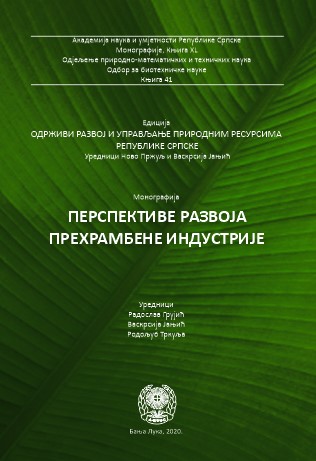Dairy by-products: characteristics and modern ways of utilization
DOI:
https://doi.org/10.7251/EORU2002315JKeywords:
Milk, By-products, Whey, Skimmed milk, Buttermilk, PermeatAbstract
The unique composition of milk makes this foodstuff an exceptional raw material for the production of new ingredients with good functional properties and the possibility of a various applications in the food industry. Therefore by-products of the milk industry that arise in special technological processes have great importance and application in the production of new generations of ingredients. Fractionation of milk is very important in the development of these products, so it was necessary to make a whole series of studies in this field, especially regarding different levels of fractionation and separation of certain milk constituents during filtration processes. This review is based on the presentation of basic characteristics of by-products which are produced during milk processing, such as whey, skim milk, buttermilk and permeate, and many possibilities of their application. Wide range of products based on dairy byproducts has been produced. Whey proteins and caseins are protein fractions which are excellent emulsifiers and protein supplements. Furthermore, they can be chemically or enzymatically modified in order to produce bioactive peptides with numerous functional and nutritional properties. In this context, techniques that enable more complete utilization of total milk proteins are being developed. Generally, proteins as important part of dry matter of by-products represent an economic and environmental problem if they are not utilized. Phospholipids originating from milk fat are excellent emulsifiers and also known as food components that exhibit excellent pharmacological activity (nutraceutical properties). In addition, the enzymatic modification of milk phospholipids makes it possible to obtain the emulsifiers with the desired functional properties. As dominant component of the dry matter of milk, lactose also has a whole range of good functional properties and allows different types of fermentations depending on the applied starter culture. Therefore it has great application in the food industry. Refined lactose is characterized by a high degree of purity, chemical and physical stability, and as such, it is applied in the pharmaceutical industry as a filler and inert tablet carrier. Also lactose can be used in the chemical industry. However, there are few more aspects to overcome, such as deeper understanding of functional and nutritional properties of these new ingredients that might be barrier for their use and acceptability. In addition, the possibility of using different components of milk dry matter in other industries, such as in the production of plastic materials, paints, textile fibers, etc., are presented in this review. New trends in nutrition, requirements for minimum processed food, ecological aspect of food production are the dominantfactors that have imposed the need for innovative approaches in creating new food products. All of the above have influenced dairy industry in order to expand the diversity of dairy products which meets the needs of the modern consumer, such as low fat and fat free milk products, high protein content products, fortified products with the addition of minerals, vitamins, etc., probiotic and prebiotic dairy products, low lactose and lactose free products, and others. All this points to the innovation potential of dairy by-products, which provides great opportunities for research and the possibility of their application in the processing of milk and dairy products.
